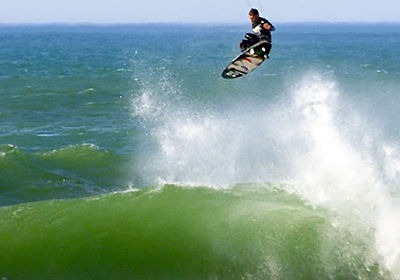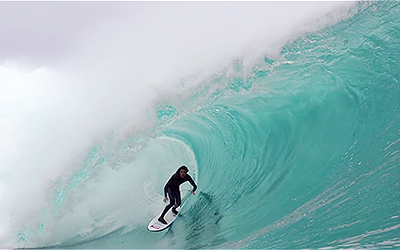Money and surf films in 2015, with Kai Neville
Words by Jake Howard Two and a half years and a purported two and a half million dollars later, we’ve been gifted our first look at John Florence’s View From A Blue Moon. From exotic locations to drones and high-speed cams, the production value is evident in every shot (based on the trailer). It got Stab wondering […]
Words by Jake Howard
Two and a half years and a purported two and a half million dollars later, we’ve been gifted our first look at John Florence’s View From A Blue Moon. From exotic locations to drones and high-speed cams, the production value is evident in every shot (based on the trailer). It got Stab wondering what’s involved, money-wise, with making a surf film in 2015, and whether a big budget translates to financial success.

If you’re invited on a surf film trip in 2015, you’ve gotta go big. Dion Agius in France, during filming for Cluster.
“A big budget certainly gives you a huge advantage,” says Kai Neville, who’s birthed classics like Modern Collective, Lost Atlas, Dear Suburbia and more recently, Cluster. “Your equipment choices are larger, you have more options with the soundtrack, and a greater ability to chase swells. More budget equals more opportunities to capture incredible surfing. But, a film still needs to click.”
As far as expenses go, RED and Phantom cam rentals add up, and drone pilots don’t come cheap either, but Kai feels the most costly part of any quality surf production is the travel.
“You take a crew of five to Europe, if it’s produced through a major brand that would be at least $30k,” says Kai. “Independently you may be able to get the surfers to help with some travel and beer and you are just covering the film crew. Travel chews up budget big time. When you get skunked it can kill your film.”
But lest we forget, the devil is in the details. As a production progresses, the more expensive it becomes. Creative ideas are great, but eventually they have to be supported by financial resources.

Mr Craig Anderson, one of Cluster’s brightest stars.
“Post-production adds up quick, you always seem to blow your budget when it comes to the latter part of film production,” says Kai. “DVD authoring, packaging and replication — not so much nowadays — but art direction, premieres, hard drives all start to drain your account. When you put so much into a single project, emotions kick in and business ethics can get thrown out the door, at the premiere you can be down to credit cards. I tend to get attached to tracks and spend way too much money, but you gotta make that part meld with the music.”
So let’s say you have an idea for a movie, a team of creative camera operators and editors, as well as the time to go out and chase the dream. Unless you’re a trustafarian, you’re going to need to raise some cash. And just where is that going to come from?
“Today it’s the surf industry,” says Kai. “Brands support both independent and branded productions. They want to sell the surfing vibe to consumers through movies. Surf films introduce the lifestyle to a huge audience, it’s directed at freesurfing and allows surfing to be not so competition-based. I grew up on surf films. I’d say in the ‘80s and ‘90s you could fund projects yourself and recoup you costs on sales pretty easily. With VHS and DVD dead it’s a little harder to recoup. iTunes, Netflix and online streaming platforms like Vimeo have shown positive results in the last five years. It’s getting better.”





Comments
Comments are a Stab Premium feature. Gotta join to talk shop.
Already a member? Sign In
Want to join? Sign Up